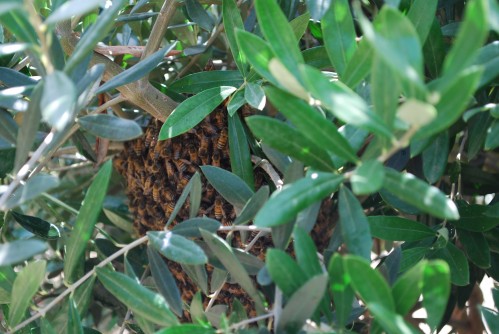 I know that nothing is a coincidence. Just last week I experienced my second honey bee swarming. The first one was in a friend's backyard a few years ago, and the second one was last week, close to our vineyard by the "Little Ollie" olive trees. At first I noticed a tiny dense dark cloud moving above our vineyard, with motion and fervor. Following this sight with my eyes for a while, it dawned on me that it was a swarm of honey bees. Upon further investigation and with the mission to water our "Little Ollie" olive trees, I spotted the swarm, quiet and resting under one of the branches. I wasn't afraid of them, and knew that they would be soon travelling on.
I know that nothing is a coincidence. Just last week I experienced my second honey bee swarming. The first one was in a friend's backyard a few years ago, and the second one was last week, close to our vineyard by the "Little Ollie" olive trees. At first I noticed a tiny dense dark cloud moving above our vineyard, with motion and fervor. Following this sight with my eyes for a while, it dawned on me that it was a swarm of honey bees. Upon further investigation and with the mission to water our "Little Ollie" olive trees, I spotted the swarm, quiet and resting under one of the branches. I wasn't afraid of them, and knew that they would be soon travelling on.
Swarming is an important part of the honey bee reproductive life cycle, and how they create new colonies for the new and old queen bees. Scouts from the swarm are sent out to find a new suitable spot for a permanent hive. In the mean time, the swarm rests, patiently protecting the queen bee, and is usually not aggressive. If you find a swarm, it is best to leave it alone. Do not spray the swarm with insecticide. Chances are the swarm will be there for only a day or two, and then move on. Contact a professional beekeeper, or your local Cooperative Extension office for questions and assistance.
We all have heard about the alarming diminishing honey bee populations in our country today. There is speculation that the bee populations might be experiencing repercussions from global warming, harmful effects from pesticides in our environment, and even experiencing some pest or fungus ravaging them. The truth is, we really don't know what is happening to our honey bee populations. This is devastating to our agricultural crops, especially almonds, and trickles down to our very own backyards, with our flower and vegetable gardens. We need bees for pollination, and of course for the golden nectar, honey.
Coincidentally last week, a special garden friend recently told me about Gretchen LeBuhn, and The Great Sunflower Project. Gretchen LeBuhn is a Bay Area biologist, who started this "grass roots" project in 2008, with little money and realistic expectations. She created a website where people could sign up, receive the specific "Lemon Queen" sunflower seeds, and then count the number of bees that visit these blooming sunflowers in their yards. This projected has blossomed to the point where she now has bee-data feedback from people in all 50 states, plus Canada. Tens of thousands of volunteers, and growing, are very concerned about the plight of the honey bee, and want to help her cause. As Gretchen LeBuhn states on her website at the bottom, "Bees: Responsible for Every Third Bite of Food".
For more coincidence, Sunset magazine's current August 2009 issue features Gretchen LeBuhn in a two page article, called "Hive Minds", page 54.
I have signed up, and you hope you will , too. Are you already part of The Great Sunflower Project? What are you finding in your own backyard with bees? All of these coincidences are a wake-up call, to help with the plight of our honey bees.

 Does your mom live a "stone's throw" away from you? Are you able to make her and all of your loved ones a delightful Mother's Day Brunch celebrating "her day" with your fresh eggs, delicately poached over heart-shaped polenta, melon-drizzled vinaigrette over arugula greens, blue cheese, and proscuitto, and gloriously ending with fresh berries and sour cream coffeecake? No, does she live out-of-state like my mom? Well, here is a great suggestion.
Does your mom live a "stone's throw" away from you? Are you able to make her and all of your loved ones a delightful Mother's Day Brunch celebrating "her day" with your fresh eggs, delicately poached over heart-shaped polenta, melon-drizzled vinaigrette over arugula greens, blue cheese, and proscuitto, and gloriously ending with fresh berries and sour cream coffeecake? No, does she live out-of-state like my mom? Well, here is a great suggestion.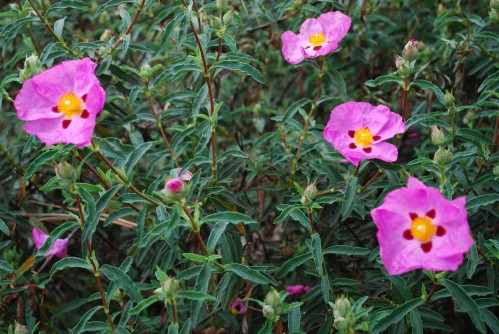 This is another spring blooming delight, Orchid Rockrose, Cistus x purpureus. Although this is a native Mediterranean drought tolerant shrub, something about it reminds me of an English country garden.
This is another spring blooming delight, Orchid Rockrose, Cistus x purpureus. Although this is a native Mediterranean drought tolerant shrub, something about it reminds me of an English country garden. 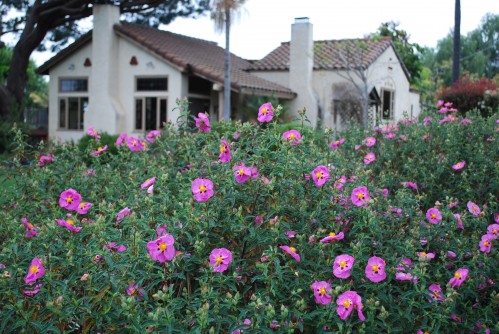
 I wanted to write about the Grey Honey Myrtle tree, because it is one of my stellar nursery choices, of the last two years. You know the ones. They catch your eye in their generic container. You have an inkling they could look nice in your garden or yard. You take them home, plant them, and you all settle in. Presto, you wonder how you ever lived without them. They do something incredible and unknown to you, such as a totally unanticipated explosion of color. Yes, it is a big deal, because there are many more lackluster nursery choices that seem to fizzle, and all with good intentions. Has this happened to you?
I wanted to write about the Grey Honey Myrtle tree, because it is one of my stellar nursery choices, of the last two years. You know the ones. They catch your eye in their generic container. You have an inkling they could look nice in your garden or yard. You take them home, plant them, and you all settle in. Presto, you wonder how you ever lived without them. They do something incredible and unknown to you, such as a totally unanticipated explosion of color. Yes, it is a big deal, because there are many more lackluster nursery choices that seem to fizzle, and all with good intentions. Has this happened to you?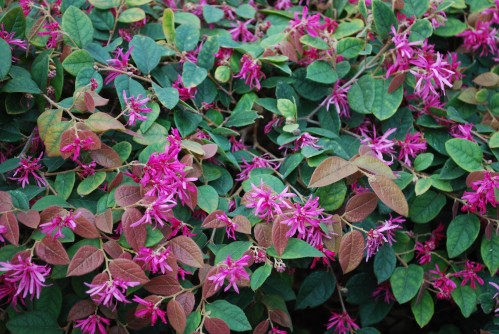
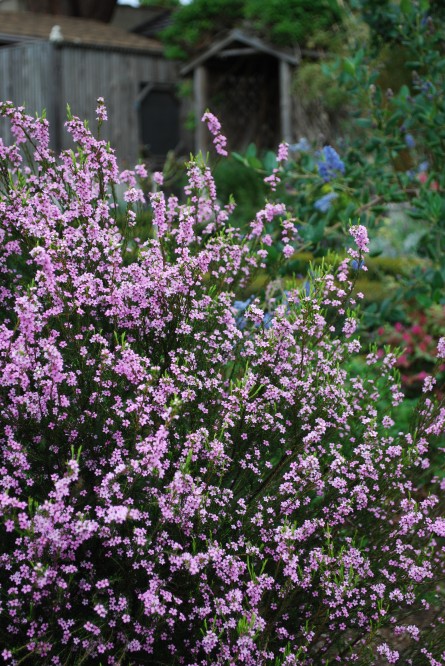 How can you not love a plant called "Pink Breath of Heaven". This shrub originally from South Africa, explodes into bloom winter to spring, with showy pink delicate tiny flowers on wispy feather-like branches. I feel like it is my own personal "trumpeter" in the garden, announcing the beginning of spring.
How can you not love a plant called "Pink Breath of Heaven". This shrub originally from South Africa, explodes into bloom winter to spring, with showy pink delicate tiny flowers on wispy feather-like branches. I feel like it is my own personal "trumpeter" in the garden, announcing the beginning of spring.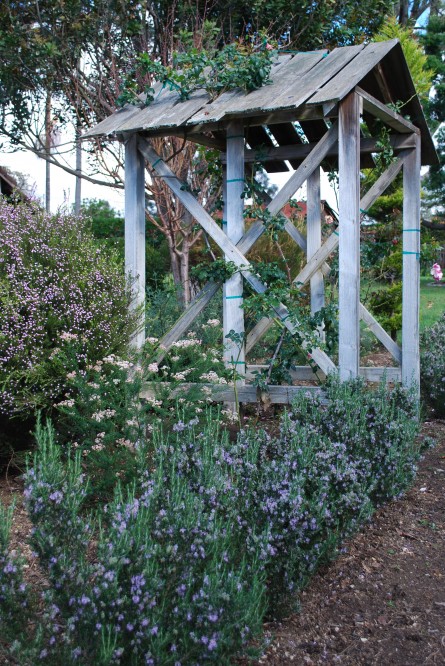 Let me introduce you to the "Majorca Pink" rosemary, Rosmarinus officinalis, "Majorca Pink", planted along the front edge of the arbor in the photo above . It is an upright rosemary which can grow 2-4 feet high, and 1-2 feet wide. It has pretty pink lilac flowers, with a hint of fragrance. Its flowers attract bees, birds, and butterflies. It blooms in the winter time here in Southern California, in my Mediterranean climate. Its flowers are edible, and can be used as a garnish. Its dark green, glossy, aromatic leaves are a great culinary herb.
Let me introduce you to the "Majorca Pink" rosemary, Rosmarinus officinalis, "Majorca Pink", planted along the front edge of the arbor in the photo above . It is an upright rosemary which can grow 2-4 feet high, and 1-2 feet wide. It has pretty pink lilac flowers, with a hint of fragrance. Its flowers attract bees, birds, and butterflies. It blooms in the winter time here in Southern California, in my Mediterranean climate. Its flowers are edible, and can be used as a garnish. Its dark green, glossy, aromatic leaves are a great culinary herb.